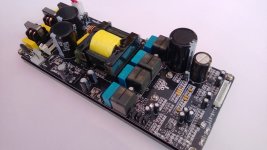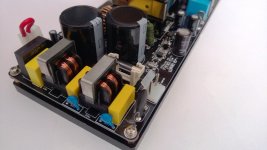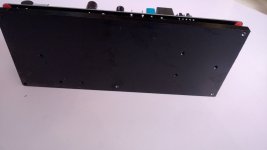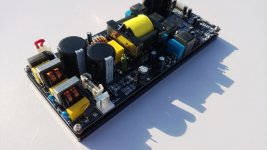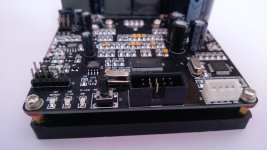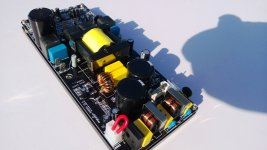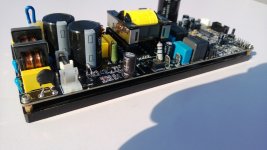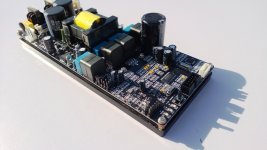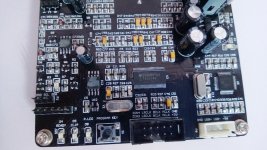Hello Mr. Lai,
Thank you for the updated information on the G300 product, and for the new photos of the G300V31 board. Please provide an update when the new G300V31 amplifier modules are available to ship. I would like to replace the G300V21 module I have that failed with the newer G300V31 board for testing.
Regarding my recommendation of an inductive virtual speaker load: The reason to create a virtual speaker load for testing class-D amplifiers is because a real speaker provides an inductive load for the amplifier, unlike a resistor which is almost purely resistive. The virtual speaker load adds a small series inductor to provide the inductance. This helps the output filter provide more extended bandwidth for the amplifier output. I hope this information helps your testing process.
Thank you for your quick reply here, we will do that quick also, Thanks again.
Mr Lai
I am interested in buying a G36D because it has all the features that I need, and I like the integration of functions.
However, I can't find any positive reviews of it on the internet. The link you provided earlier in this thread to the D class amplifier shootout was neutral/negative and the only comments from a DiyAudio member said the unit wouldn't win any audio competitions and that he had to fix the speaker terminals. Quality control appears to be an ongoing problem.
If the G36D still cost $400 I would probably risk it. However, at the new price of over $700AU plus postage it is too much to risk without a good independent review. The 8 week wait for a unit doesn't bother me by itself but indicates potential manufacturing problems.
Can you provide a link to positive reviews? Alternatively, I suggest you submit a unit for review by a reputable tester.
I am interested in buying a G36D because it has all the features that I need, and I like the integration of functions.
However, I can't find any positive reviews of it on the internet. The link you provided earlier in this thread to the D class amplifier shootout was neutral/negative and the only comments from a DiyAudio member said the unit wouldn't win any audio competitions and that he had to fix the speaker terminals. Quality control appears to be an ongoing problem.
If the G36D still cost $400 I would probably risk it. However, at the new price of over $700AU plus postage it is too much to risk without a good independent review. The 8 week wait for a unit doesn't bother me by itself but indicates potential manufacturing problems.
Can you provide a link to positive reviews? Alternatively, I suggest you submit a unit for review by a reputable tester.
Thank you here, we alway receive any scathing criticism from your country and we lost amp and money in your country too, we have to connect your new PM(Kevin Rudd) who know Chinese well and maybe they will help us to recover our debts,
we suggest you can order over 50units in one order, so we can give you very well idea price , you know batch manufacture faster and good and cost lower, you know sample cost high due to hand made.
if come to China next time, welcome to our office and i will lead you to visit our amp line you will know how hard to finish one G36D. it cost very high. so we have to sell high, we are losing money when we sell 400usd/unit.
thank you again for your supports, you can leaves words here and give us posotive evaluation. you know it is well enough amp, why not!
connect us directly, maybe we can disucss with others and give you well price and shorter delivery time.
thank you again!
any good suggestions or ideas, pls let us know! We will with preferential price in return.
By the way , we are developing one new amp for home theatre, 8ch with tas5631B , we use TAS555 as core DSP, of course , PFC stage +SMPS+4pcs TAs5631B+TAS5558 all in one board.
we can OEM this amp to any customers, i sure it sound better and quanlity good.if like connect us.
we suggest you can order over 50units in one order, so we can give you very well idea price , you know batch manufacture faster and good and cost lower, you know sample cost high due to hand made.
if come to China next time, welcome to our office and i will lead you to visit our amp line you will know how hard to finish one G36D. it cost very high. so we have to sell high, we are losing money when we sell 400usd/unit.
thank you again for your supports, you can leaves words here and give us posotive evaluation. you know it is well enough amp, why not!
connect us directly, maybe we can disucss with others and give you well price and shorter delivery time.
thank you again!
any good suggestions or ideas, pls let us know! We will with preferential price in return.
By the way , we are developing one new amp for home theatre, 8ch with tas5631B , we use TAS555 as core DSP, of course , PFC stage +SMPS+4pcs TAs5631B+TAS5558 all in one board.
we can OEM this amp to any customers, i sure it sound better and quanlity good.if like connect us.
Mr Lai
I am interested in buying a G36D because it has all the features that I need, and I like the integration of functions.
However, I can't find any positive reviews of it on the internet. The link you provided earlier in this thread to the D class amplifier shootout was neutral/negative and the only comments from a DiyAudio member said the unit wouldn't win any audio competitions and that he had to fix the speaker terminals. Quality control appears to be an ongoing problem.
If the G36D still cost $400 I would probably risk it. However, at the new price of over $700AU plus postage it is too much to risk without a good independent review. The 8 week wait for a unit doesn't bother me by itself but indicates potential manufacturing problems.
Can you provide a link to positive reviews? Alternatively, I suggest you submit a unit for review by a reputable tester.
ok! customer can adjust the volume and EQ and limiter themselves by computer software, simaliar as TI EVM supported control console software.
http://www.ti.com/lit/ug/slou351/slou351.pdf
we are developing one HDMI HD decoder now, it is 7.1 channel, it have spdif input and HDMI input and analog input, it match with above amp.
http://www.ti.com/lit/ug/slou351/slou351.pdf
we are developing one HDMI HD decoder now, it is 7.1 channel, it have spdif input and HDMI input and analog input, it match with above amp.
looking good. Can the 7 biquads per channel be used for digital crossover and/or eq. If not four spdif inputs, would be nice.
Also Power supply volume control sounds interesting. Will that part be supported in your design?
By the way , we are developing one new amp for home theatre, 8ch with tas5631B , we use TAS555 as core DSP, of course , PFC stage +SMPS+4pcs TAs5631B+TAS5558 all in one board.
we can OEM this amp to any customers, i sure it sound better and quanlity good.if like connect us.
I would be interested in an amplifier like this, based on the TAS55x8 and TAS5631B chipset. When will it be available for purchase?
Cheers,
Mike
Genius200 (G300V21 board with TAS5613) Review
Recently I felt compelled to take another look at my Genius200 amp from Sinewave Audio, since I learned that Peachtree Audio's new Decco65 amplifier also uses the TAS5631 Class-D IC that is used in the Genius200 (though they have their own board with separate linear power supply and their component layout is different, appearing to be based on the TI reference evaluation board for the TAS5631). The Decco65 was reviewed well by Stereophile, so I thought, why not give the Genius200 another shot?
In the course of this narrative, I lost a channel on my regular Class-AB amplifier (which is a 200WPC unit into 4 ohms, 135W into 8 ohms), so with the Sinewave amp being the only other moderate to high power amplifier I have in house at present, I decided to hook it up directly to my Mark Levinson preamp and high-end DAC for some more serious listening than I had been doing before (where I had connected my CD player's output directly to the unit and using the front-mounted volume control). With the preamp in the chain, I set my Genius200 volume knob to full.
I have been critical of the Genius300 amplifier in the past for having a somewhat high noise floor - audible at the listening position through speakers of typical sensitivity. The Genius200 by comparison has slightly lower noise through ordinary speakers (I used a pair of Klipsch RB-25 mass-market bookshelf speakers for this test), but my speakers for listening are fairly beefy mini-monitors with low-ish sensitivity (~82 dB 1W/1m), due to the fact that their crossovers use full baffle step compensation. They are a DIY construction with a Tang Band W4-1720 underhung midbass driver and SEAS 22TAF/G tweeter, with a crossover designed in Jeff Bagby's PCD program and verified through measurements. Through these speakers, the noise level of the Genius200 was low enough that it receded into the noise floor of the room - barely perceptible. As I have said before, anything that Sinewave Audio can do to further reduce this noise floor would be beneficial to the product. While the feedback systems used by most class-D ICs are able to achieve high levels of power supply noise rejection, I don't think this feedback should be entirely relied upon to reduce PSU noise - it already has its hands full with lowering the distortion of the amplifier with an audio signal, without also having to clean up the power supply to the output devices.
My Genius200 came from the factory with a volume potentiometer that was noticeably mismatched between the left and right channels, with the right channel being louder, though at the maximum setting the mismatch became negligible. This made it difficult to use my Genius200 with sources like smartphones, laptops, or PCs, because I would need to run their digital volume controls at low levels, not helping the noise floor issue. Where I work, however, we had evaluated an older Sinewave Genius300 amplifier, but after testing it had begun to emit a strange smell from its PSU, so we had called it dead and put it on our shelf. I was able to take the ALPS 50KAX2 potentiometer and PC board assembly from the older Genius300 and swap it for the one in my Genius200, which corrected my issue. It would be good for Sinewave to test the fully assembled Genius amplifiers to make sure this volume mismatch doesn't exist, though I think they do test the amp modules thoroughly. I should further note that even though the Genius300 sample unit at my work started emitting the distinctive 'burning transistor smell', my own Genius200 unit has been trouble-free.
Moving on to the sound of the Genius200 unit, I can report that I think I like the sound of the unit better now than I did when I first purchased it. It is a very different animal from my mosfet-based class-AB amplifier, with a tonal balance that is more neutral to cool, while my class-AB amp (Hafler 9270) was neutral to warm by comparison. The Genius200 is based upon the Texas Instruments TAS5613 PurePath HD amplifier IC, which is a quad-half-bridge design where two half-bridges are strapped together to form a full bridge for each channel, operating at 65W into 8 ohms at 1% THD, or 125W into 4 ohms at 1% THD. The 150WPC rating of the IC is based on a 10% THD figure, which I would consider unacceptable from any type of amp, so I prefer to consider the TAS5613 (and by extension the Genius200) as a 125WPC amplifier. This still gives the unit a combined output of 250W. I have read that the TAS5613 is considered to be a better-sounding IC than the TAS5630 on which the larger Sinewave Genius300 amp is based, and I can confirm this. If you need big power on the cheap, consider the Genius300 (with TAS5630), but if the most nuanced presentation is your priority, then choose the Genius200 (with TAS5613).
I found the Genius200 to provide an excellent level of detail, pulling lots of information out of any recording I gave it, though I settled on three recordings for my critical listening: Jennifer Warnes' The Hunter, Sera Una Noche's La Segunda, and Richard Page's Shelter Me. While I will say the Genius200 is not the most transparent amplifier I have heard, it certainly might be the most transparent IC-based class-D amplifier I have heard (among amps based on ICs from Tripath and ST Micro). I have heard ICEpower amps sound marginally better (with fuller, weightier images and warmer tonal balance), but I have not heard any Hypex-based amps. Imaging from the Genius200 was very good, with accurate and repeatable placement of instruments and singers, particularly near the center of the image, though I felt the image was not as sharply defined at the extremes of left and right. Soundstaging was fairly deep (and with the Sera Una Noche album, very wide and spacious as well, with good decay of reverb), but images were placed behind the speakers rather than in front of them, and they were not as palpable as I have heard from my Class-AB amp.
As I said above, sonic detail was very present, and I got a strong impression of clarity and speed. The famous class-D bass presentation was in full effect, with the small woofers in my mini-monitors staying well controlled even though they throbbed mightily to deliver impactful bass. I think one benefit to ordering the Genius200 is that the same power supply is used for the G300V21 amp module with the 300WPC TAS5630 or the 150WPC TAS5613, so the power supply is under lighter demand from the TAS5613 chip and it can deliver plenty of current into the load. My speakers are 4-ohm speakers, so I could be sure they were under the control of the full available 125W of power from this amplifier. Even though bass was furiously controlled, it still had weight and richness that helped keep things satisfying, especially on the Richard Page album (which straddles R&B, blues, and jazz - think of him as a male Tracy Chapman) where the bass guitar and kick drum seemed to energize the entire room from the tiny 4.5" midwoofers of my mini-monitors - a surprising feat that I've only heard from this amplifier.
Throughout my listening, I didn't notice any artifacts (such as HF hash or midrange glare) that would detract or distract from my listening enjoyment, even though I have heard these from other IC-based class-D amplifiers. The Genius200 kept up well with elevated volumes and energetic program material. Only when I played extremely harmonically complex material from the Finnish orchestral band Nightwish's latest Imaginaerum album did the amp seem to begin having trouble with midrange coherence, seeming to start presenting a wall of sonic energy, but occasionally sonic details did arise over the melange of heavily distorted metal guitars, and the bass remained tight and fast. It's possible that what I was hearing was just the very matter-of-fact, un-sweetened sound of this amp when applied to my favorite metal recordings. I should reiterate - there are no sweeteners in this amp, just a very straightforward, detailed, and controlled presentation. Amps like these are an indication that class-D (and particularly affordable IC-based class-D) amps are finally beginning to rise to the levels of performance demanded by commodity high-end. These IC-based amps are becoming very good.
To conclude, I think I may have been overly and unfairly critical of the Sinewave Genius amps in the past, but the time I have been spending with the Genius200 lately has begun to change my opinion for the better. I think there are still things that Sinewave can do (and hopefully has done with the new G300V30 module design) to improve the performance of this amp, mainly through lowering the noise floor and being more careful about unit-to-unit consistency, but if you lack the funds for a more expensive amp then there's definitely no reason to shy away from the Genius200 amp. It is an excellent value.
Another area where Sinewave could improve their product line is to offer the SMPS and the amplifier section as separate modules, which could be combined by amplifier designers in a single chassis as needed. The modules could be available in stereo and PBTL mono configurations to suit a wide array of applications. This is similar to what is currently offered by Hypex.
Recently I felt compelled to take another look at my Genius200 amp from Sinewave Audio, since I learned that Peachtree Audio's new Decco65 amplifier also uses the TAS5631 Class-D IC that is used in the Genius200 (though they have their own board with separate linear power supply and their component layout is different, appearing to be based on the TI reference evaluation board for the TAS5631). The Decco65 was reviewed well by Stereophile, so I thought, why not give the Genius200 another shot?
In the course of this narrative, I lost a channel on my regular Class-AB amplifier (which is a 200WPC unit into 4 ohms, 135W into 8 ohms), so with the Sinewave amp being the only other moderate to high power amplifier I have in house at present, I decided to hook it up directly to my Mark Levinson preamp and high-end DAC for some more serious listening than I had been doing before (where I had connected my CD player's output directly to the unit and using the front-mounted volume control). With the preamp in the chain, I set my Genius200 volume knob to full.
I have been critical of the Genius300 amplifier in the past for having a somewhat high noise floor - audible at the listening position through speakers of typical sensitivity. The Genius200 by comparison has slightly lower noise through ordinary speakers (I used a pair of Klipsch RB-25 mass-market bookshelf speakers for this test), but my speakers for listening are fairly beefy mini-monitors with low-ish sensitivity (~82 dB 1W/1m), due to the fact that their crossovers use full baffle step compensation. They are a DIY construction with a Tang Band W4-1720 underhung midbass driver and SEAS 22TAF/G tweeter, with a crossover designed in Jeff Bagby's PCD program and verified through measurements. Through these speakers, the noise level of the Genius200 was low enough that it receded into the noise floor of the room - barely perceptible. As I have said before, anything that Sinewave Audio can do to further reduce this noise floor would be beneficial to the product. While the feedback systems used by most class-D ICs are able to achieve high levels of power supply noise rejection, I don't think this feedback should be entirely relied upon to reduce PSU noise - it already has its hands full with lowering the distortion of the amplifier with an audio signal, without also having to clean up the power supply to the output devices.
My Genius200 came from the factory with a volume potentiometer that was noticeably mismatched between the left and right channels, with the right channel being louder, though at the maximum setting the mismatch became negligible. This made it difficult to use my Genius200 with sources like smartphones, laptops, or PCs, because I would need to run their digital volume controls at low levels, not helping the noise floor issue. Where I work, however, we had evaluated an older Sinewave Genius300 amplifier, but after testing it had begun to emit a strange smell from its PSU, so we had called it dead and put it on our shelf. I was able to take the ALPS 50KAX2 potentiometer and PC board assembly from the older Genius300 and swap it for the one in my Genius200, which corrected my issue. It would be good for Sinewave to test the fully assembled Genius amplifiers to make sure this volume mismatch doesn't exist, though I think they do test the amp modules thoroughly. I should further note that even though the Genius300 sample unit at my work started emitting the distinctive 'burning transistor smell', my own Genius200 unit has been trouble-free.
Moving on to the sound of the Genius200 unit, I can report that I think I like the sound of the unit better now than I did when I first purchased it. It is a very different animal from my mosfet-based class-AB amplifier, with a tonal balance that is more neutral to cool, while my class-AB amp (Hafler 9270) was neutral to warm by comparison. The Genius200 is based upon the Texas Instruments TAS5613 PurePath HD amplifier IC, which is a quad-half-bridge design where two half-bridges are strapped together to form a full bridge for each channel, operating at 65W into 8 ohms at 1% THD, or 125W into 4 ohms at 1% THD. The 150WPC rating of the IC is based on a 10% THD figure, which I would consider unacceptable from any type of amp, so I prefer to consider the TAS5613 (and by extension the Genius200) as a 125WPC amplifier. This still gives the unit a combined output of 250W. I have read that the TAS5613 is considered to be a better-sounding IC than the TAS5630 on which the larger Sinewave Genius300 amp is based, and I can confirm this. If you need big power on the cheap, consider the Genius300 (with TAS5630), but if the most nuanced presentation is your priority, then choose the Genius200 (with TAS5613).
I found the Genius200 to provide an excellent level of detail, pulling lots of information out of any recording I gave it, though I settled on three recordings for my critical listening: Jennifer Warnes' The Hunter, Sera Una Noche's La Segunda, and Richard Page's Shelter Me. While I will say the Genius200 is not the most transparent amplifier I have heard, it certainly might be the most transparent IC-based class-D amplifier I have heard (among amps based on ICs from Tripath and ST Micro). I have heard ICEpower amps sound marginally better (with fuller, weightier images and warmer tonal balance), but I have not heard any Hypex-based amps. Imaging from the Genius200 was very good, with accurate and repeatable placement of instruments and singers, particularly near the center of the image, though I felt the image was not as sharply defined at the extremes of left and right. Soundstaging was fairly deep (and with the Sera Una Noche album, very wide and spacious as well, with good decay of reverb), but images were placed behind the speakers rather than in front of them, and they were not as palpable as I have heard from my Class-AB amp.
As I said above, sonic detail was very present, and I got a strong impression of clarity and speed. The famous class-D bass presentation was in full effect, with the small woofers in my mini-monitors staying well controlled even though they throbbed mightily to deliver impactful bass. I think one benefit to ordering the Genius200 is that the same power supply is used for the G300V21 amp module with the 300WPC TAS5630 or the 150WPC TAS5613, so the power supply is under lighter demand from the TAS5613 chip and it can deliver plenty of current into the load. My speakers are 4-ohm speakers, so I could be sure they were under the control of the full available 125W of power from this amplifier. Even though bass was furiously controlled, it still had weight and richness that helped keep things satisfying, especially on the Richard Page album (which straddles R&B, blues, and jazz - think of him as a male Tracy Chapman) where the bass guitar and kick drum seemed to energize the entire room from the tiny 4.5" midwoofers of my mini-monitors - a surprising feat that I've only heard from this amplifier.
Throughout my listening, I didn't notice any artifacts (such as HF hash or midrange glare) that would detract or distract from my listening enjoyment, even though I have heard these from other IC-based class-D amplifiers. The Genius200 kept up well with elevated volumes and energetic program material. Only when I played extremely harmonically complex material from the Finnish orchestral band Nightwish's latest Imaginaerum album did the amp seem to begin having trouble with midrange coherence, seeming to start presenting a wall of sonic energy, but occasionally sonic details did arise over the melange of heavily distorted metal guitars, and the bass remained tight and fast. It's possible that what I was hearing was just the very matter-of-fact, un-sweetened sound of this amp when applied to my favorite metal recordings. I should reiterate - there are no sweeteners in this amp, just a very straightforward, detailed, and controlled presentation. Amps like these are an indication that class-D (and particularly affordable IC-based class-D) amps are finally beginning to rise to the levels of performance demanded by commodity high-end. These IC-based amps are becoming very good.
To conclude, I think I may have been overly and unfairly critical of the Sinewave Genius amps in the past, but the time I have been spending with the Genius200 lately has begun to change my opinion for the better. I think there are still things that Sinewave can do (and hopefully has done with the new G300V30 module design) to improve the performance of this amp, mainly through lowering the noise floor and being more careful about unit-to-unit consistency, but if you lack the funds for a more expensive amp then there's definitely no reason to shy away from the Genius200 amp. It is an excellent value.
Another area where Sinewave could improve their product line is to offer the SMPS and the amplifier section as separate modules, which could be combined by amplifier designers in a single chassis as needed. The modules could be available in stereo and PBTL mono configurations to suit a wide array of applications. This is similar to what is currently offered by Hypex.
Last edited:
Thank you for your reply, if met background noise ,you can try the way to connect heatsink to earth ,you know it need three wire for common application,safety and quiet,we can provide two new board next week.
G300V31: 500W SMPS+ Tas5630B or TAS5613A
G300V31D: 500W SMPS+ TAS5548+tas5631B, it is I2s input, and support TI PurePathTM Console graphic software realtime download,it is stereo amp and new type all digital board , welcome friend to try it and give us more suggestions.
G300V31: 500W SMPS+ Tas5630B or TAS5613A
G300V31D: 500W SMPS+ TAS5548+tas5631B, it is I2s input, and support TI PurePathTM Console graphic software realtime download,it is stereo amp and new type all digital board , welcome friend to try it and give us more suggestions.
Recently I felt compelled to take another look at my Genius200 amp from Sinewave Audio, since I learned that Peachtree Audio's new Decco65 amplifier also uses the TAS5631 Class-D IC that is used in the Genius200 (though they have their own board with separate linear power supply and their component layout is different, appearing to be based on the TI reference evaluation board for the TAS5631). The Decco65 was reviewed well by Stereophile, so I thought, why not give the Genius200 another shot?
In the course of this narrative, I lost a channel on my regular Class-AB amplifier (which is a 200WPC unit into 4 ohms, 135W into 8 ohms), so with the Sinewave amp being the only other moderate to high power amplifier I have in house at present, I decided to hook it up directly to my Mark Levinson preamp and high-end DAC for some more serious listening than I had been doing before (where I had connected my CD player's output directly to the unit and using the front-mounted volume control). With the preamp in the chain, I set my Genius200 volume knob to full.
I have been critical of the Genius300 amplifier in the past for having a somewhat high noise floor - audible at the listening position through speakers of typical sensitivity. The Genius200 by comparison has slightly lower noise through ordinary speakers (I used a pair of Klipsch RB-25 mass-market bookshelf speakers for this test), but my speakers for listening are fairly beefy mini-monitors with low-ish sensitivity (~82 dB 1W/1m), due to the fact that their crossovers use full baffle step compensation. They are a DIY construction with a Tang Band W4-1720 underhung midbass driver and SEAS 22TAF/G tweeter, with a crossover designed in Jeff Bagby's PCD program and verified through measurements. Through these speakers, the noise level of the Genius200 was low enough that it receded into the noise floor of the room - barely perceptible. As I have said before, anything that Sinewave Audio can do to further reduce this noise floor would be beneficial to the product. While the feedback systems used by most class-D ICs are able to achieve high levels of power supply noise rejection, I don't think this feedback should be entirely relied upon to reduce PSU noise - it already has its hands full with lowering the distortion of the amplifier with an audio signal, without also having to clean up the power supply to the output devices.
My Genius200 came from the factory with a volume potentiometer that was noticeably mismatched between the left and right channels, with the right channel being louder, though at the maximum setting the mismatch became negligible. This made it difficult to use my Genius200 with sources like smartphones, laptops, or PCs, because I would need to run their digital volume controls at low levels, not helping the noise floor issue. Where I work, however, we had evaluated an older Sinewave Genius300 amplifier, but after testing it had begun to emit a strange smell from its PSU, so we had called it dead and put it on our shelf. I was able to take the ALPS 50KAX2 potentiometer and PC board assembly from the older Genius300 and swap it for the one in my Genius200, which corrected my issue. It would be good for Sinewave to test the fully assembled Genius amplifiers to make sure this volume mismatch doesn't exist, though I think they do test the amp modules thoroughly. I should further note that even though the Genius300 sample unit at my work started emitting the distinctive 'burning transistor smell', my own Genius200 unit has been trouble-free.
Moving on to the sound of the Genius200 unit, I can report that I think I like the sound of the unit better now than I did when I first purchased it. It is a very different animal from my mosfet-based class-AB amplifier, with a tonal balance that is more neutral to cool, while my class-AB amp (Hafler 9270) was neutral to warm by comparison. The Genius200 is based upon the Texas Instruments TAS5613 PurePath HD amplifier IC, which is a quad-half-bridge design where two half-bridges are strapped together to form a full bridge for each channel, operating at 65W into 8 ohms at 1% THD, or 125W into 4 ohms at 1% THD. The 150WPC rating of the IC is based on a 10% THD figure, which I would consider unacceptable from any type of amp, so I prefer to consider the TAS5613 (and by extension the Genius200) as a 125WPC amplifier. This still gives the unit a combined output of 250W. I have read that the TAS5613 is considered to be a better-sounding IC than the TAS5630 on which the larger Sinewave Genius300 amp is based, and I can confirm this. If you need big power on the cheap, consider the Genius300 (with TAS5630), but if the most nuanced presentation is your priority, then choose the Genius200 (with TAS5613).
I found the Genius200 to provide an excellent level of detail, pulling lots of information out of any recording I gave it, though I settled on three recordings for my critical listening: Jennifer Warnes' The Hunter, Sera Una Noche's La Segunda, and Richard Page's Shelter Me. While I will say the Genius200 is not the most transparent amplifier I have heard, it certainly might be the most transparent IC-based class-D amplifier I have heard (among amps based on ICs from Tripath and ST Micro). I have heard ICEpower amps sound marginally better (with fuller, weightier images and warmer tonal balance), but I have not heard any Hypex-based amps. Imaging from the Genius200 was very good, with accurate and repeatable placement of instruments and singers, particularly near the center of the image, though I felt the image was not as sharply defined at the extremes of left and right. Soundstaging was fairly deep (and with the Sera Una Noche album, very wide and spacious as well, with good decay of reverb), but images were placed behind the speakers rather than in front of them, and they were not as palpable as I have heard from my Class-AB amp.
As I said above, sonic detail was very present, and I got a strong impression of clarity and speed. The famous class-D bass presentation was in full effect, with the small woofers in my mini-monitors staying well controlled even though they throbbed mightily to deliver impactful bass. I think one benefit to ordering the Genius200 is that the same power supply is used for the G300V21 amp module with the 300WPC TAS5630 or the 150WPC TAS5613, so the power supply is under lighter demand from the TAS5613 chip and it can deliver plenty of current into the load. My speakers are 4-ohm speakers, so I could be sure they were under the control of the full available 125W of power from this amplifier. Even though bass was furiously controlled, it still had weight and richness that helped keep things satisfying, especially on the Richard Page album (which straddles R&B, blues, and jazz - think of him as a male Tracy Chapman) where the bass guitar and kick drum seemed to energize the entire room from the tiny 4.5" midwoofers of my mini-monitors - a surprising feat that I've only heard from this amplifier.
Throughout my listening, I didn't notice any artifacts (such as HF hash or midrange glare) that would detract or distract from my listening enjoyment, even though I have heard these from other IC-based class-D amplifiers. The Genius200 kept up well with elevated volumes and energetic program material. Only when I played extremely harmonically complex material from the Finnish orchestral band Nightwish's latest Imaginaerum album did the amp seem to begin having trouble with midrange coherence, seeming to start presenting a wall of sonic energy, but occasionally sonic details did arise over the melange of heavily distorted metal guitars, and the bass remained tight and fast. It's possible that what I was hearing was just the very matter-of-fact, un-sweetened sound of this amp when applied to my favorite metal recordings. I should reiterate - there are no sweeteners in this amp, just a very straightforward, detailed, and controlled presentation. Amps like these are an indication that class-D (and particularly affordable IC-based class-D) amps are finally beginning to rise to the levels of performance demanded by commodity high-end. These IC-based amps are becoming very good.
To conclude, I think I may have been overly and unfairly critical of the Sinewave Genius amps in the past, but the time I have been spending with the Genius200 lately has begun to change my opinion for the better. I think there are still things that Sinewave can do (and hopefully has done with the new G300V30 module design) to improve the performance of this amp, mainly through lowering the noise floor and being more careful about unit-to-unit consistency, but if you lack the funds for a more expensive amp then there's definitely no reason to shy away from the Genius200 amp. It is an excellent value.
Another area where Sinewave could improve their product line is to offer the SMPS and the amplifier section as separate modules, which could be combined by amplifier designers in a single chassis as needed. The modules could be available in stereo and PBTL mono configurations to suit a wide array of applications. This is similar to what is currently offered by Hypex.
I cannot agree more with your statement here! I think they would sell even more of their boards this wayAnother area where Sinewave could improve their product line is to offer the SMPS and the amplifier section as separate modules, which could be combined by amplifier designers in a single chassis as needed. The modules could be available in stereo and PBTL mono configurations to suit a wide array of applications. This is similar to what is currently offered by Hypex.
Thank you for your reply, if met background noise ,you can try the way to connect heatsink to earth ,you know it need three wire for common application,safety and quiet,we can provide two new board next week.
G300V31: 500W SMPS+ Tas5630B or TAS5613A
G300V31D: 500W SMPS+ TAS5548+tas5631B, it is I2s input, and support TI PurePathTM Console graphic software realtime download,it is stereo amp and new type all digital board , welcome friend to try it and give us more suggestions.
I would like to try the TAS5548/TAS5631B amplifier, please let me know cost and delivery details to New Zealand.
I already have PurePath Console on my computer, and I also have a TAS5548EVM.
Thanks!
Mike
Thank you for your reply here, better price for you, pls mail to us, authlxl@gmail.com
what would be the price of your tas5631b boards?
Thank you for your reply here, better price for you, pls mail to us, authlxl@gmail.com
I would like to try the TAS5548/TAS5631B amplifier, please let me know cost and delivery details to New Zealand.
I already have PurePath Console on my computer, and I also have a TAS5548EVM.
Thanks!
Mike
Reply mail sent.
Thanks
Thanks
Thank you Mr Lai, I have sent you an email.
Best regards,
Mike
Thank you for your reply, if met background noise ,you can try the way to connect heatsink to earth ,you know it need three wire for common application,safety and quiet,we can provide two new board next week.
G300V31: 500W SMPS+ Tas5630B or TAS5613A
G300V31D: 500W SMPS+ TAS5548+tas5631B, it is I2s input, and support TI PurePathTM Console graphic software realtime download,it is stereo amp and new type all digital board , welcome friend to try it and give us more suggestions.
I appreciate the input. Please understand that my review is for the older G300V21 module, not the newer G300V30 or G300V31 boards. I will need to listen to one of the newer boards to comment on how they sound. My G200 amplifier was electrically grounded to the same ground connection as my preamp and CD player.
I will be in contact with you soon about how to order a G300V31 board with TAS5613A.
I cannot agree more with your statement here! I think they would sell even more of their boards this wayAnother area where Sinewave could improve their product line is to offer the SMPS and the amplifier section as separate modules, which could be combined by amplifier designers in a single chassis as needed. The modules could be available in stereo and PBTL mono configurations to suit a wide array of applications. This is similar to what is currently offered by Hypex
I think the following complement of modular products based on TAS5613/TAS5630 would perform very well in the market:
500W Audio SMPS board: Same SMPS as currently on the board for G300V31, for driving one stereo or one PBTL amplifier module.
1200W Audio SMPS board: For driving two TAS5630B-PBTL amplifier modules (providing 600W each), or one TAS5630B stereo amplifier module where extreme high current is needed for improved bass.
600W Linear Audio PSU board: Linear power supply for use with 600VA transformer of proper secondary voltage to supply power to amp modules - includes rectifier bridge, filtering capacitors, and reservoir capacitors for driving one TAS5613A stereo module, one TAS5630B stereo module, or one TAS5630-PBTL mono module.
TAS5613A Stereo Amp Module (No PSU): Component selection same as the amplifier section of the G300V31 board but with TAS5613A chip - requires external PSU
TAS5630B Stereo Amp Module (No PSU): Component selection same as amplifier section of the G300V31 board but with TAS5630B chip - requires external PSU
TAS5630B-PBTL Mono Amp Module (No PSU): Component selection same as amplifier section of the G300V31 board but with TAS5630 chip configured for PBTL - requires external PSU
Provide 0.250 fast-on connections between boards for DC power and speaker output, not molex type - this will make the products easier to use for DIY customers, while industrial customers can still use them easily. My big complaint with the ICEpower boards is that I can't assemble the wire harness connectors, so the way Sinewave currently does it is better. I also prefer the way the heatsink is an aluminum plate on the bottom of the Sinewave modules so they can be mounted to any aluminum surface for heat transfer. This seems like the best way to provide the needed heat transfer for the SMPS and the TAS5630 chip. It is a good, smart design.
That is how I think a line of modular amplifier components could be set up. These modular products should be offered together with the existing complete G300V31 modules to allow amp designers to create the solution that their project needs by combining modules.
Last edited:
G300VV31 V2.0 UPDATE
Long time testing , G300v31 boards are manufacturing now.latest version is v2.0 now
two chip version TAS5613A and TAS5630B
TAS5630B version specifictions:
1. full 400W rms power out one module.
2. Half bridge LLC power supply .
3.Shield output inductor and very few influence to radio.
4. 2channel output:
2x200W/4ohm@0.5%THD+N
2X300W/4ohm@10%THD+N
5. 1channel output:
1X400W/2ohm@1%THD+N
6. Balance signal input.
7. Every channel work status indictor
8.Clip signal indicator
9.110v or 230V ac supply
10. AC supply fuse on board
11.8mm thickness aluminum plate heatsink, 2X3mm assembling hole support.
TAS5613A version specifictions:same board as TAS5630B
1. full 400W rms power out one module (@3ohm loder).
2. Half bridge LLC power supply .
3.Shield output inductor and very few influence to radio.
4. 2channel output:
2x120W/4ohm@0.5%THD+N
2X150W/4ohm@10%THD+N
5. 1channel output:
1X250W/2ohm@1%THD+N
6. Balance signal input.
7. Every channel work status indictor
8.Clip signal indicator
9.110v or 230V ac supply
10. AC supply fuse on board
11.8mm thickness aluminum plate heatsink, 2X3mm assembling hole support.
Long time testing , G300v31 boards are manufacturing now.latest version is v2.0 now
two chip version TAS5613A and TAS5630B
TAS5630B version specifictions:
1. full 400W rms power out one module.
2. Half bridge LLC power supply .
3.Shield output inductor and very few influence to radio.
4. 2channel output:
2x200W/4ohm@0.5%THD+N
2X300W/4ohm@10%THD+N
5. 1channel output:
1X400W/2ohm@1%THD+N
6. Balance signal input.
7. Every channel work status indictor
8.Clip signal indicator
9.110v or 230V ac supply
10. AC supply fuse on board
11.8mm thickness aluminum plate heatsink, 2X3mm assembling hole support.
TAS5613A version specifictions:same board as TAS5630B
1. full 400W rms power out one module (@3ohm loder).
2. Half bridge LLC power supply .
3.Shield output inductor and very few influence to radio.
4. 2channel output:
2x120W/4ohm@0.5%THD+N
2X150W/4ohm@10%THD+N
5. 1channel output:
1X250W/2ohm@1%THD+N
6. Balance signal input.
7. Every channel work status indictor
8.Clip signal indicator
9.110v or 230V ac supply
10. AC supply fuse on board
11.8mm thickness aluminum plate heatsink, 2X3mm assembling hole support.
Attachments
Last edited:
G300V31D UPDATE,TAS5548/TAS5558+TAS5631B
TAS5548/TAS5558+TAS5631B circuits testing finish now, works well , latest version G300V31D V1.2 .
Suppor TI pure path console software, customer can adjust it's EQ/LIMITER/MIXER/INPUT OUTPUT CHANNEL real time and download to board, it support alone runing function, if press download key on board , all the parameterS will be wrote to EEPROM and can run as your set when power on.
Specifications:
1. two channel IIS digital signal input, up to 192Khz/24bit
2. USB programmer on board ,support USB audio input and output.
3. IIC control port on board,support customer program.
4. full 400W rms power out one module.
5. Half bridge LLC power supply .
6. Shield output inductor and very few influence to radio.
7. 2channel output:
2x200W/4ohm@0.5%THD+N
2X300W/4ohm@10%THD+N
8. 1channel output:
1X400W/2ohm@1%THD+N
9. Every channel work status indictor
10.Clip signal indicator
11.110v or 230V ac supply
12. AC supply fuse on board
13.8mm thickness aluminum plate heatsink, 2X3mm assembling hole support.
14.Dimensions:235mm(L)x91mm(W)x52mm(H)
15.Weight:0.88Kg
TAS5548/TAS5558+TAS5631B circuits testing finish now, works well , latest version G300V31D V1.2 .
Suppor TI pure path console software, customer can adjust it's EQ/LIMITER/MIXER/INPUT OUTPUT CHANNEL real time and download to board, it support alone runing function, if press download key on board , all the parameterS will be wrote to EEPROM and can run as your set when power on.
Specifications:
1. two channel IIS digital signal input, up to 192Khz/24bit
2. USB programmer on board ,support USB audio input and output.
3. IIC control port on board,support customer program.
4. full 400W rms power out one module.
5. Half bridge LLC power supply .
6. Shield output inductor and very few influence to radio.
7. 2channel output:
2x200W/4ohm@0.5%THD+N
2X300W/4ohm@10%THD+N
8. 1channel output:
1X400W/2ohm@1%THD+N
9. Every channel work status indictor
10.Clip signal indicator
11.110v or 230V ac supply
12. AC supply fuse on board
13.8mm thickness aluminum plate heatsink, 2X3mm assembling hole support.
14.Dimensions:235mm(L)x91mm(W)x52mm(H)
15.Weight:0.88Kg
Attachments
Last edited:
DP2500 2ch multifeedback class D amp finished
DP2500 2X500w multifeedback class D amp is manufacturing now, have pass our strict test. works well now. latest version is DP2500 V1.3
Specifications:
1.OUTPUT :
2x500W/4ohm@1%THD+N
1x2000w/4om@1%THD+N
2.S/N:-101dB.
3. Frequency Response(8ohms):20-20Khz +/-0.5dB
4. Damping Factor (8 ohms): 260
5. Variable Fan cooling system
6. Full protection system:OTP/OVP/OCP/UVP/DCP.
support no loader and high load shorted output test .
7.Dimensions: 152mm(W)x250mm(L)x70mm(H)
8. Weight:1.78Kg
DP2500 2X500w multifeedback class D amp is manufacturing now, have pass our strict test. works well now. latest version is DP2500 V1.3
Specifications:
1.OUTPUT :
2x500W/4ohm@1%THD+N
1x2000w/4om@1%THD+N
2.S/N:-101dB.
3. Frequency Response(8ohms):20-20Khz +/-0.5dB
4. Damping Factor (8 ohms): 260
5. Variable Fan cooling system
6. Full protection system:OTP/OVP/OCP/UVP/DCP.
support no loader and high load shorted output test .
7.Dimensions: 152mm(W)x250mm(L)x70mm(H)
8. Weight:1.78Kg
Attachments
-
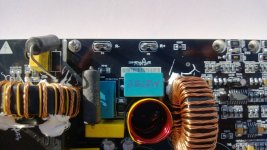 WP_20130829_080_86.jpg147.8 KB · Views: 62
WP_20130829_080_86.jpg147.8 KB · Views: 62 -
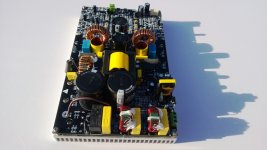 WP_20130829_078_86.jpg117.1 KB · Views: 56
WP_20130829_078_86.jpg117.1 KB · Views: 56 -
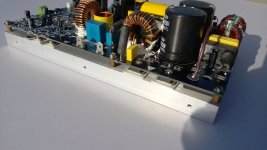 WP_20130829_077_86.jpg119.4 KB · Views: 62
WP_20130829_077_86.jpg119.4 KB · Views: 62 -
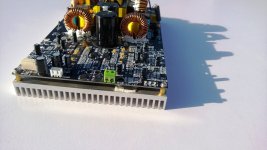 WP_20130829_073_86.jpg129.2 KB · Views: 71
WP_20130829_073_86.jpg129.2 KB · Views: 71 -
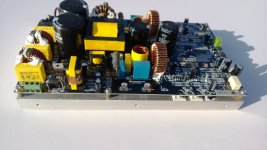 WP_20130829_072_86.jpg129.1 KB · Views: 68
WP_20130829_072_86.jpg129.1 KB · Views: 68 -
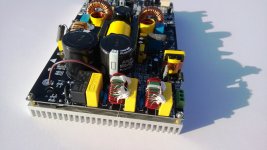 WP_20130829_071_86.jpg125.8 KB · Views: 78
WP_20130829_071_86.jpg125.8 KB · Views: 78 -
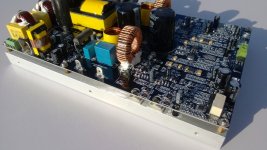 WP_20130829_068_86.jpg150 KB · Views: 106
WP_20130829_068_86.jpg150 KB · Views: 106 -
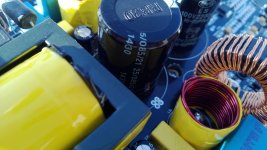 WP_20130829_085_86.jpg135 KB · Views: 60
WP_20130829_085_86.jpg135 KB · Views: 60
Last edited:
TAS5548/TAS5558+TAS5631B circuits testing finish now, works well , latest version G300V31D V1.2 .
Suppor TI pure path console software, customer can adjust it's EQ/LIMITER/MIXER/INPUT OUTPUT CHANNEL real time and download to board, it support alone runing function, if press download key on board , all the parameterS will be wrote to EEPROM and can run as your set when power on.
Specifications:
1. two channel IIS digital signal input, up to 192Khz/24bit
2. USB programmer on board ,support USB audio input and output.
3. IIC control port on board,support customer program.
4. full 400W rms power out one module.
5. Half bridge LLC power supply .
6. Shield output inductor and very few influence to radio.
7. 2channel output:
2x200W/4ohm@0.5%THD+N
2X300W/4ohm@10%THD+N
8. 1channel output:
1X400W/2ohm@1%THD+N
9. Every channel work status indictor
10.Clip signal indicator
11.110v or 230V ac supply
12. AC supply fuse on board
13.8mm thickness aluminum plate heatsink, 2X3mm assembling hole support.
14.Dimensions:235mm(L)x91mm(W)x52mm(H)
15.Weight:0.88Kg
Does it support USB audio input from PC, or is it just USB programming - I think both is said in the text, so I'm a bit confused.
- Status
- This old topic is closed. If you want to reopen this topic, contact a moderator using the "Report Post" button.
- Home
- Vendor's Bazaar
- Tas5630+smps+aluminum case finished!new year coming!
